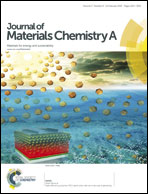High-efficiency polymer–PbS hybrid solar cells via molecular engineering†
Abstract
Solution-processed hybrid solar cells (HSCs), composed of conjugated polymers and semiconducting PbS nanocrystals, are promising candidates for the next-generation photovoltaic devices. Through deliberate molecular design, a series of new organic donor–acceptor polymers bearing varying optical band-gaps (1.25–1.65 eV) and suitable HOMO (highest occupied molecular orbital) energy levels (∼5.0 eV) were synthesized. Due to improved device architecture, we achieved the highest power conversion efficiency (PCE) of 4.23% to date for polymer–PbS based HSCs. Furthermore, the correlation between the polymer molecular structure and hybrid blend morphologies was systematically investigated using 2-dimensional grazing incidence X-ray diffraction, atomic force microscopy and scanning transmission electron microscopy. We believe our findings can be beneficial to the future molecular design toward highly efficient polymer–PbS HSCs.


 Please wait while we load your content...
Please wait while we load your content...